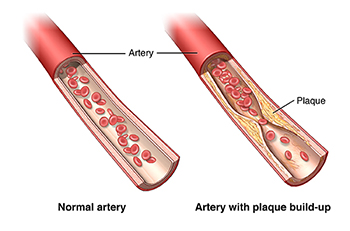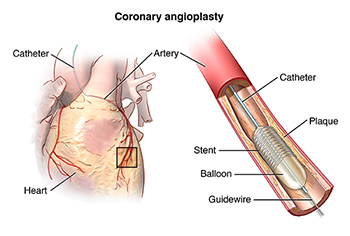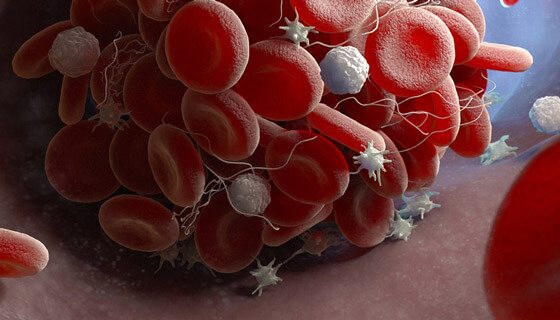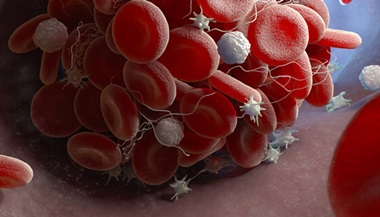Atherosclerosis
What is atherosclerosis?
Atherosclerosis thickening or hardening of the arteries. It is caused by a buildup of plaque in the inner lining of an artery.

Plaque is made up of deposits of fatty substances, cholesterol, cellular waste products, calcium, and fibrin. As it builds up in the arteries, the artery walls become thickened and stiff.
Atherosclerosis is a slow, progressive disease that may start as early as childhood. However, it can progress rapidly.
What causes atherosclerosis?
It's not clear exactly how atherosclerosis starts or what causes it. However, a gradual buildup of plaque or thickening due to inflammation occurs on the inside of the walls of the artery. This reduces blood flow and oxygen supply to the vital body organs and extremities.
What are the risk factors for atherosclerosis?
Risk factors for atherosclerosis, include:
-
High cholesterol and triglyceride levels
-
High blood pressure
-
Smoking
-
Type 1 diabetes
-
Obesity
-
Physical inactivity
-
High saturated fat diet
What are the symptoms of atherosclerosis?
Signs and symptoms of atherosclerosis may develop gradually, and may be few, as the plaque gradually builds up in the artery. Symptoms may also vary depending on the affected artery. However, when a major artery is blocked, signs and symptoms may be severe, such as those occurring with heart attack, stroke, or blood clot.
The symptoms of atherosclerosis may look like other heart conditions. See your healthcare provider for a diagnosis.
How is atherosclerosis diagnosed?
First, your doctor will do a complete medical history and physical exam. You may also have one or more of these tests:
-
Cardiac catheterization. With this procedure, a long thin tube (catheter) is passed into the coronary arteries. X-rays are taken after a dye is injected into an artery to locate the narrowing, blockages, and other abnormalities of specific arteries.
-
Doppler sonography. A special probe is used to direct sound waves into a blood vessel to evaluate blood flow. An audio receiver amplifies the sound of the blood moving though the vessel. Faintness or absence of sound may mean there is a blockage. This is used to identify narrowing of the blood vessels of the abdomen, neck, or legs.
-
Blood pressure comparison. Comparing blood pressure measurements in the ankles and in the arms helps determine any constriction in blood flow. Significant differences may mean blood vessels are narrowed due to atherosclerosis.
-
MUGA/radionuclide angiography. This is a nuclear scan to see how the heart wall moves and how much blood is expelled with each heartbeat, while the person is at rest.
-
Thallium/myocardial perfusion scan. This is a nuclear scan given while the person is at rest or after exercise that may reveal areas of the heart muscle that are not getting enough blood.
-
Computerized tomography or CT. This is a type of X-ray test that can see if there is coronary calcification that may suggest a future heart problem.
How is atherosclerosis treated?
Treatment for atherosclerosis may include lifestyle changes, medicine, and surgery.
Lifestyle changes
You can change some risk factors for atherosclerosis such as smoking, high cholesterol levels, high blood sugar (glucose) levels, lack of exercise, poor dietary habits, and high blood pressure.
Medicines
Medicines that may be used to treat atherosclerosis include:
-
Antiplatelet medicines. These are medicines used to decrease the ability of platelets in the blood to stick together and cause clots. Aspirin, clopidogrel, ticlopidine, and dipyridamole are examples of antiplatelet medicines.
-
Anticoagulants. Also called blood thinners, these medicines work differently from antiplatelet medicines to decrease the ability of the blood to clot. Warfarin and heparin are examples of anticoagulants.
-
Cholesterol-lowering medicines. These are medicines used to lower fats (lipids) in the blood, particularly low density lipid (LDL) cholesterol. Statins are a group of cholesterol-lowering medicines. They include simvastatin, atorvastatin, and pravastatin among others. Bile acid sequestrants—colesevelam, cholestyramine and colestipol—and nicotinic acid are other types of medicine that may be used to reduce cholesterol levels. Your doctor may also prescribe fibrates to help improve your cholesterol and triglyceride levels.
-
Blood pressure medicines. Several different groups of medicines act in different ways to lower blood pressure.
Coronary angioplasty

With this procedure, a long thin tube (catheter) is thread through a blood vessel to the heart. There, a balloon is inflated to create a bigger opening in the vessel to increase blood flow. Although angioplasty is done in other blood vessels elsewhere in the body, percutaneous coronary intervention (PCI) refers to angioplasty in the coronary arteries to permit more blood flow into the heart. There are several types of PCI procedures, including:
-
Balloon angioplasty. A small balloon is inflated inside the blocked artery to open the blocked area.
-
Atherectomy. The blocked area inside the artery is shaved away by a tiny device on the end of a catheter.
-
Laser angioplasty. A laser used to vaporize the blockage in the artery.
-
Coronary artery stent. A tiny mesh coil is expanded inside the blocked artery to open the blocked area and is left in place to keep the artery open.
Coronary artery bypass
Most commonly referred to as bypass surgery, this surgery is often done in people who have angina (chest pain) due to coronary artery disease (where plaque has built up in the arteries). During the surgery, a bypass is created by grafting a piece of a healthy vein from elsewhere in the body and attaching it above and below the blocked area of a coronary artery. This lets blood flow around the blockage. Veins are usually taken from the leg or from the chest wall. Sometimes more than one artery needs to be bypassed during the same surgery.
What are the complications of atherosclerosis?
Plaque buildup inside the arteries reduces the blood flow. A heart attack may occur if the blood supply is reduced to the heart. A damaged heart muscle may not pump as well and can lead to heart failure. A stroke may occur if the blood supply is cut off to the brain. Severe pain and tissue death may occur if the blood supply is reduced to the arms and legs.
Can atherosclerosis be prevented?
You can prevent or delay atherosclerosis by reducing risk factors. This includes adopting a healthy lifestyle. A healthy diet, losing weight, being physically active, and not smoking can help reduce your risk of atherosclerosis. A healthy diet includes fruits, vegetables, whole grains, lean meats, skinless chicken, seafood, and fat-free or low-fat dairy products. A healthy diet also limits sodium, refined sugars and grains, and solid fats.
If you are at risk for atherosclerosis because of family history, or high cholesterol, it is important that you take medicines as directed by your healthcare provider.
When should I call my healthcare provider?
If your symptoms get worse or you have new symptoms, let your healthcare provider know.
Key points of atherosclerosis
-
Atherosclerosis is thickening or hardening of the arteries caused by a buildup of plaque in the inner lining of an artery.
-
Risk factors may include high cholesterol and triglyceride levels, high blood pressure, smoking, diabetes, obesity, physical activity, and eating saturated fats.
-
Atherosclerosis can cause a heart attack, stroke, aneurysm, or blood clot.
-
You may need medicine, treatments, or surgery to reduce the complications of atherosclerosis.





